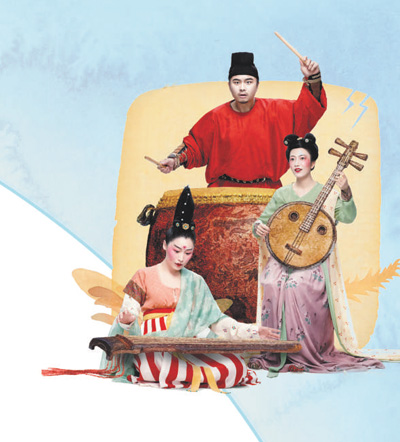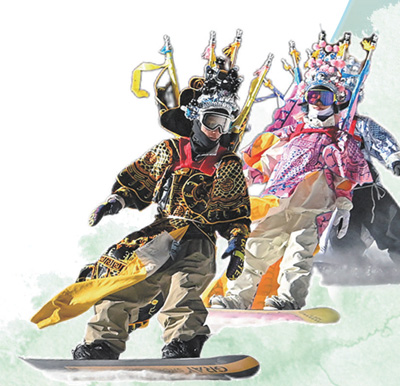




- BRNN
- BRI News
- BRNN News
- Database
Official Documents Polices and Regulations
Inter-government Documents International Cooperation BRI Countries
Business Guide Economic Data BRI Data
Trade
Investment Projects Latest projects
Cases - Content Pool
With the arrival of the winter snow season, people were delighted to find a striking splash of "Chinese red" on the pristine white snow. At the Lake Songhua Resort in Jilin city, northeast China's Jilin Province, young skiers clad in Peking Opera costumes raced down a mountain, exuding youthful energy amidst their swift descents.
From Chinese-style clothing and cultural creations to traditional tea beverages, the vigor of youth has merged with the elegance of Chinese culture. The creative spirit of innovation has intertwined with the profound wisdom of tradition, blending the centuries-old heritage of Chinese civilization into modern lifestyles. This burgeoning "Guochao," or "China-chic," trend is capturing the hearts of the younger generation.

Photo shows a stage photo of a concert by Zi De Guqin Studio, an ensemble whose members play traditional Chinese instruments. (Photo courtesy of the interviewee)
Today, more and more young people are infusing ancient culture with youthful vitality. Through the balance of inheritance and innovation, they demonstrate a strong sense of cultural confidence, bringing fresh appeal to China's rich traditional heritage in the new era.
Li Xiao, a Chinese student studying abroad, returned home to reunite with her family for the upcoming Spring Festival in Hangzhou, east China's Zhejiang Province. She was searching for new Chinese-style clothing at a clothing market.
"I plan to wear it for reunion dinners, and I also want to showcase the beauty of traditional Chinese culture to my classmates from other countries through my clothes," she said.
Today, young people have emerged as a significant driving force behind the rise of "Guochao," a fashion trend that blends modern designs with traditional Chinese cultural elements. On search engines, the search volume for "Guochao" has increased more than five times in the past decade.
"Guochao" has transitioned from a niche concept to a popular trend among the general public, with young individuals engaging in the process of embracing, participating in, understanding, and creating "Guochao." They have become a powerful force in promoting and preserving traditional Chinese culture.
To commemorate its 10th anniversary, Zi De Guqin Studio, an ensemble consisting of musicians playing traditional Chinese instruments, hosted a concert at the New Bund 31 Performing Arts Center in Shanghai during the Mid-Autumn Festival in September 2024. The venue was filled with over 2,000 spectators, with many adorned in Hanfu, the traditional attire of the Han ethnic group in China.

A visitor poses for a picture with a woman wearing Hanfu, the traditional clothing of the Han ethnic group in China, at the British Museum in the UK. (Xinhua/Li Ying)
According to Zhu Liyue, head of Zi De Guqin Studio, the studio's creations are rooted in their deep passion for traditional culture. As audience expectations for top-notch cultural products continue to rise, the team must derive inspiration from history to create artistic pieces that meet the audience's demands.
A report released by video-streaming platform Bilibili in 2022 revealed that individuals aged 18 to 30 accounted for approximately 70 percent of enthusiasts of Chinese-style elements on the platform.
Winter is typically considered a slow season for visiting north China's Shanxi Province to admire ancient architecture. However, Xiaoxitian Temple, a scenic spot in Linfen city of the province, has been attracting a steady stream of tourists.
"The main hall of the temple showcases over 1,900 intricately carved colored sculptures that are remarkably lifelike and more captivating than those found in the video game 'Black Myth: Wukong'," mentioned a tourist surnamed Lu from south China's Guangdong Province.
In August 2024, "Black Myth: Wukong," an action role-playing game, gained popularity on Chinese and international social media platforms. The game piqued the curiosity of foreign internet users regarding Chinese elements. To help them grasp the game's context, numerous Chinese gamers shared photos, texts, and videos introducing the iconic Chinese novel, "Journey to the West," which served as the inspiration for the game.
Young people are increasingly eager to tell China's stories and share them with the world while expressing their individuality, reflecting a significant increase in cultural confidence.

Ski enthusiasts adorned in Peking Opera costumes ski at the Lake Songhua Resort in Jilin city, northeast China's Jilin Province. (Xinhua/Zhang Nan)
"The young people grew up witnessing China's rapid economic development, technological progress, growing national strength and increasing global influence. They are used to the image of China as a major country, having deep-rooted cultural confidence," said Xiang Yong, director of the Institute for Cultural Industries, Peking University.
In Chuxiong Yi Autonomous Prefecture, southwest China's Yunnan Province, Chen Haiyan, an inheritor of Yi embroidery clothes, has been busy fulfilling orders from countries like France, Vietnam, and Japan with the help of her embroidery team.
After graduating from university in 2022, Chen returned to her hometown to become an embroiderer. Combining popular colors and patterns favored by young people, she has developed over 200 clothing designs using techniques such as embroidery, patchwork, and printing and dyeing, and even made an appearance at Milan Fashion Week in Milan, Italy.
In recent years, China has seen a wave of high-quality products with Chinese flair in beauty, fashion, food, cultural and creative sectors, and electronics. The upgrade of Chinese manufacturing is the bedrock of the craze for "Guochao."
"Before young people explore the world, China is already on par with it," said Xiang. This shift is changing the consumption habits of young people, who now value not just the functionality of products but also their spiritual and cultural significance.
"The emergence of Chinese-style products blending tradition with a modern touch is backed by the younger generation, who are both key consumers and inheritors of traditional Chinese culture. They are actively supporting the revival and growth of Chinese culture and industries," Xiang noted.

Tel:86-10-65363107, 86-10-65368220, 86-10-65363106